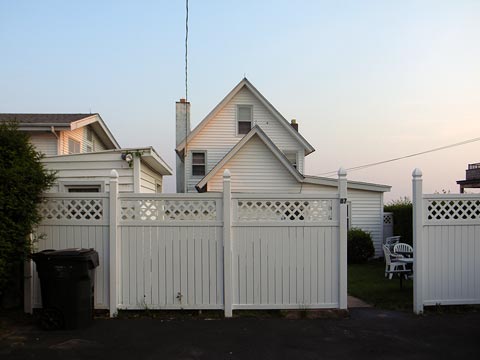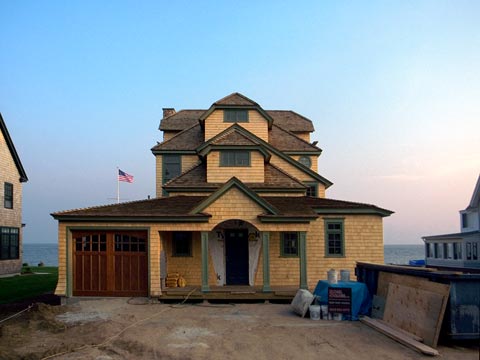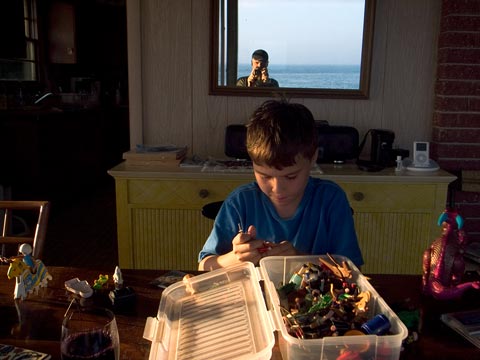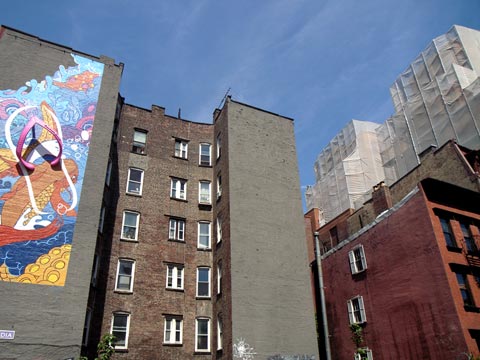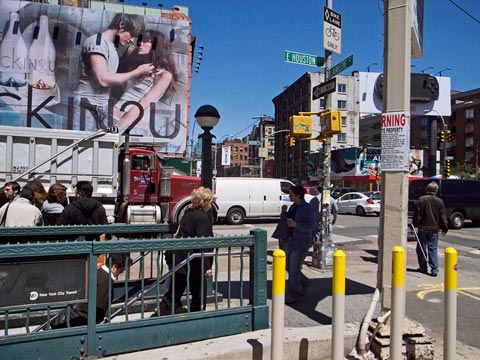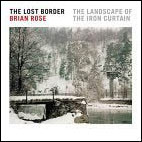Thursday, May 31, 2007
Tuesday, May 29, 2007
New York/Dutch Architecture
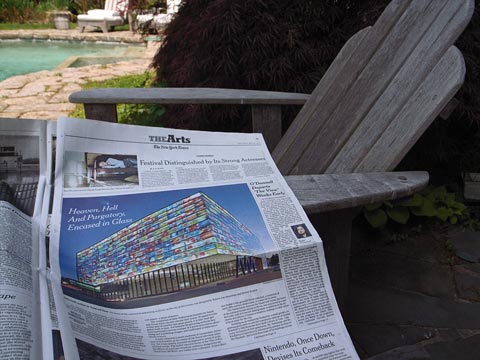
Dutch architecture in the Saturday New York Times.
One of the most prominent of the so-called baby Rems (Rem Koolhaas) is the firm of Willem Jan Neutelings and Michiel Riedijk. I first came across Neutelings' work while photographing design models for a building on Mercatorplein, a public square, in Amsterdam. His proposal seemed a little cartoonish to me at the time. And some of the firm's subsequent work edges along the line between goofball and sophisticated humor in a Robert Venturi kind of way. Whatever my ambivalence about their work, I'd love to see them do something in New York.
But see for yourself on their very clear and easy to navigate website.
The building in the Times looks gorgeous to me. The setting--the media center in Hilversum--is not so gorgeous, but you won't see that in the pictures. Take it from me as a professional architectural photographer. You haven't seen a building unless you've seen it person.
Friday, May 25, 2007
Tuesday, May 22, 2007
New York/Long Island City
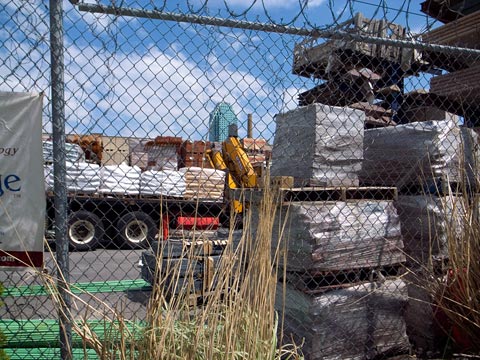
Long Island City
I wasn't familiar with the French designer/architect Jean Prouvé until several years ago when I photographed an auction house in New York that was selling some of his furniture. He is well-known in France, less so over here. When I read that his Maison Tropicale, a metal kit house, was on display in Queens, I organized a family outing, and off we went through the wilds of Long Island City.
 Con Ed and Midtown skyline
Con Ed and Midtown skylineLIC is the neighborhood just across the East River from the United Nations. It's a hodgepodge of factories, lofts, single family houses, and a new high rise enclave known as Queens West. PS 1, the former school turned modern museum is in LIC as is the Citigroup tower that pokes skyward above everything.
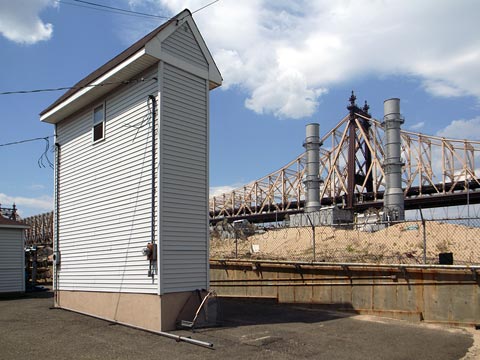
Con Ed and 59th Street Bridge
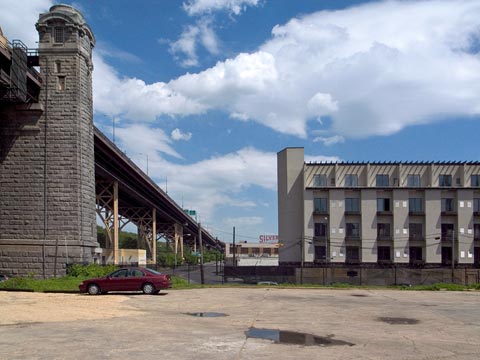 Bridge and hotel under construction
Bridge and hotel under constructionWe took the 7 train over and began walking north toward the 59th Street Bridge. I took lots of pictures of the crazy quilt landscape along the way. Chain link, slabs of concrete, poles, trucks, auto body shops. On the left was a Con Ed power plant with the Midtown skyline as backdrop. Some sort of electrical shed was disguised as a clapboard house complete with slanted roof and window. Just at the bridge, a hotel--looking like a ruin--was, apparently, nearing completion.
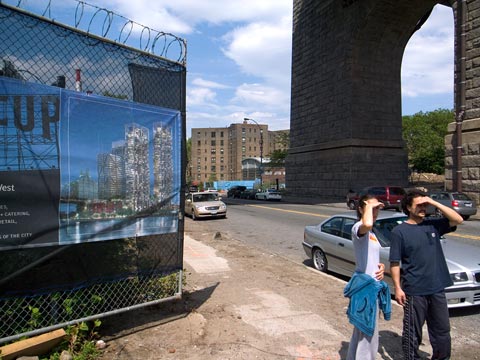
Silvercup poster
As we entered the fenced in area where the Prouvé house was displayed, we passed a poster advertising the upcoming Silvercup development, designed by Richard Rodgers, soon to go up on the site. Just over a rise, toward the river, the little metal house stood beneath the towering stone and steel bridge.
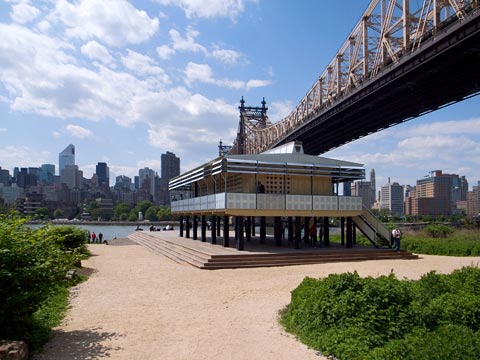
Maison Tropicale
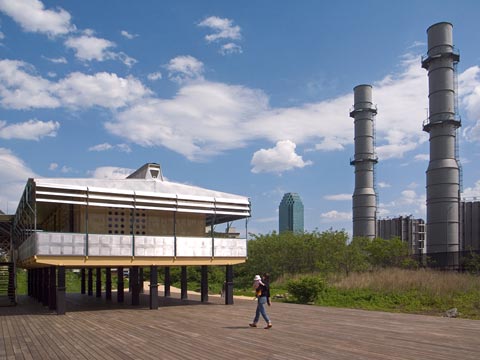
Maison Tropicale
A steady stream of visitors found their way to the site by foot, car, and bicycle. It was a sophisticated looking bunch. Foreign languages. Everyone taking pictures. Inside the house, book were on sale, and the porthole windows in the sliding doors cast a blue glow. Christies is expecting 4 to 6 million for the house, but it could go higher. So says someone quoted in the paper. The house will undoubtedly be fabulous on someone's estate, or in a museum courtyard, but it will never be seen better than here in Long Island City.

Maison Tropicale
Labels: Long Island City
Sunday, May 20, 2007
Thursday, May 17, 2007
New York/Williamsburg
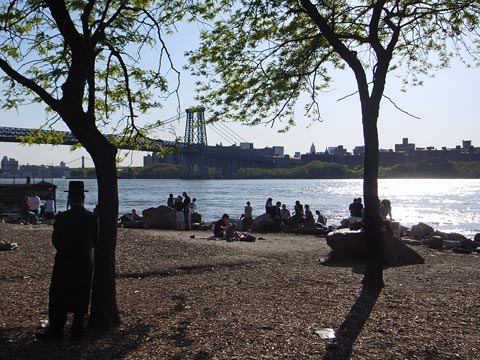
Grand Ferry Park, the Williamsburg Bridge
Took a long walk through Williamsburg the other day. It's a neighborhood that, some years ago, supplanted the Lower East Side as a haven for creative newcomers to New York. Depending on your perspective, it is either already over, or it is just coming into its own. In any case, it is now seeing expensive condos and loft conversions amidst the urban grit.
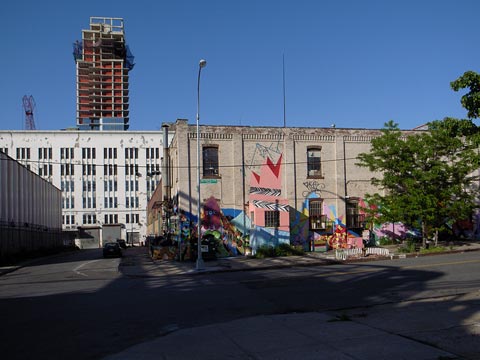
Williamsburg with Toll Brothers luxury housing rising in the background
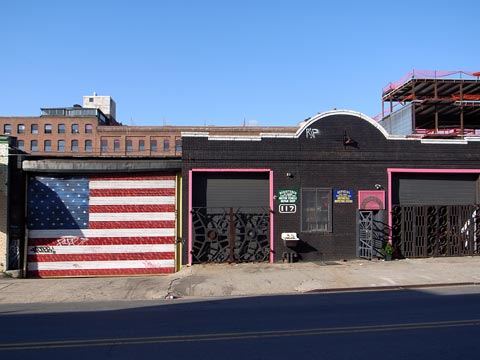
Williamsburg
There are loft buildings, row houses, vacant lots, and pockets of ongoing industrial use. To the north is Greenpoint with its Polish population and to the south just below the Williamsburg Bridge there are enclaves of orthodox Jews. As a Manhattanite, I still feel a little like a foreigner in Williamsburg. But it's one of the parts of the city outside my precious island that I would consider living in.
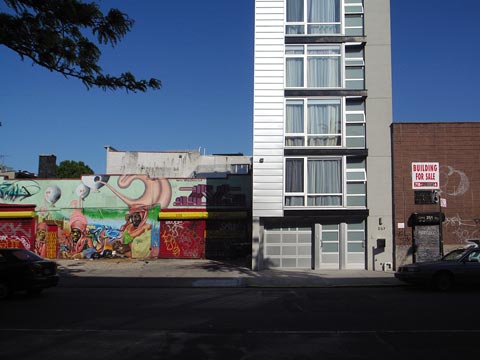
Williamsburg
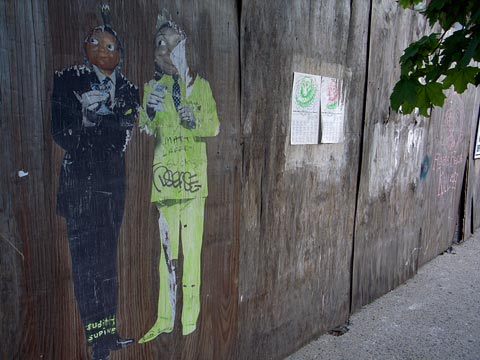
Williamsburg
Despite it's hipster reputation, Williamsburg remains a largely low income neighborhood with a significant Latino community. To the east it blends into Bushwick, a mostly African American area. There are housing projects as well as lots of single family homes. It was traditionally a blue collar place, and that aspect of it has not all together disappeared.
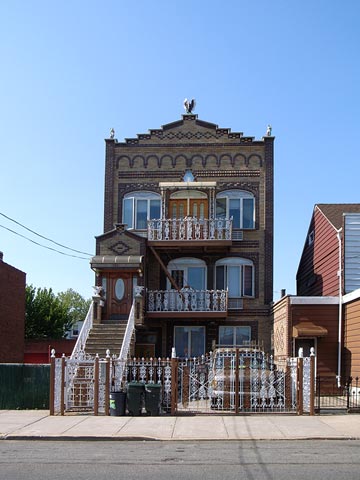
Williamsburg
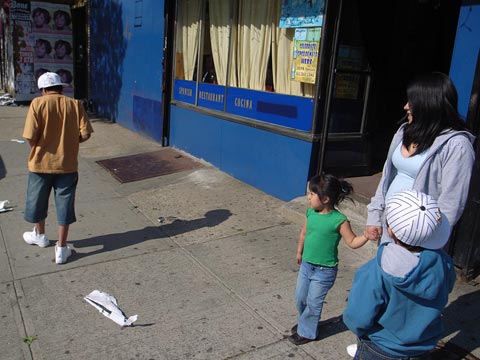
Williamsburg
Sunday, May 13, 2007
Tuesday, May 08, 2007
New York/LES
On the Lower East Side along Houston Street there are numerous buildings going up. One is a real monster, designed by the ubiquitous Costas Kondylis, towering above Katz's Deli. This is your basic bland Manhattan high rise, the kind of building occupied by people you never meet, planted in a neighborhood where funky and chic collide.
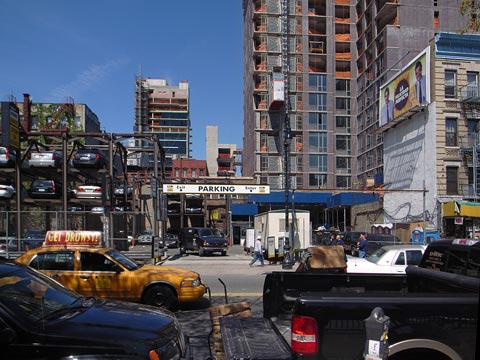
Essex Street near Houston Street
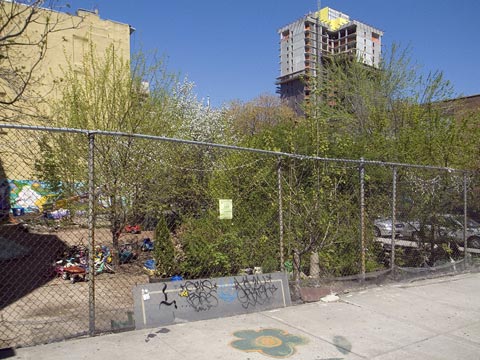
Norfolk and Stanton Streets
I circled the scene of the crime with my view camera looking for views that included, but did not necessarily focus on the building. I looked across Allen Street toward a multi-layered hodgepodge of tenements, stacked cars, and new construction. From there I headed for Norfolk Street past a school playground ending up at the corner of Stanton Street where a fenced in vacant lot serves as a children's play area. In the distance, The Ludlow, as it is called, looms above the trees and a painted flower on the sidewalk.
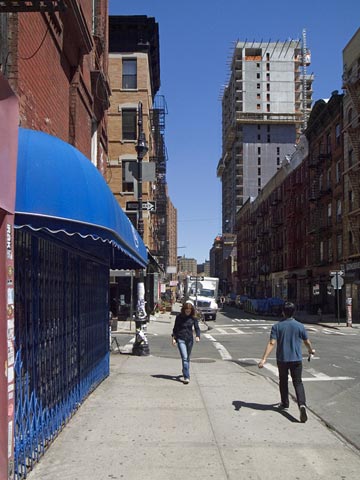
Ludlow and Stanton Streets

Essex Street near Houston Street

Norfolk and Stanton Streets
I circled the scene of the crime with my view camera looking for views that included, but did not necessarily focus on the building. I looked across Allen Street toward a multi-layered hodgepodge of tenements, stacked cars, and new construction. From there I headed for Norfolk Street past a school playground ending up at the corner of Stanton Street where a fenced in vacant lot serves as a children's play area. In the distance, The Ludlow, as it is called, looms above the trees and a painted flower on the sidewalk.

Ludlow and Stanton Streets
Monday, May 07, 2007
New York/LES
New photographs of the Lower East Side. I continue to work on this never-ending project, still looking for a venue for showing this--I think--extraordinary encapsulation of New York history. It is important for any number of reasons, not the least of which is that the Lower East Side is America's quintessential immigrant neighborhood, a portal through which millions of people can trace their ancestry and arrival in the United States. It is now undergoing fundamental change, reflecting the rapid transformation of the city since 9/11.
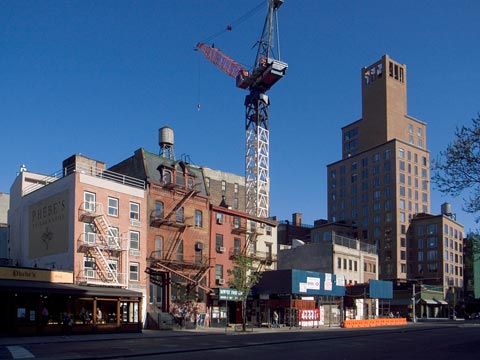
The Bowery at East 4th Street
I did a few new pictures of the Bowery/Third Avenue north of Houston Street adjacent to the East Village. There are numerous buildings new or under construction along this stretch. At the Bowery and East 4th Street I did a wide shot of a group of low structures--some quite old--with the ultra chic Bowery Hotel towering above. A crane stands in a small vacant lot suggesting a very tall, thin, building to come.
Although there are some in the neighborhood who see the Bowery Hotel as out-of-scale--it replaces a grungy gas station that stood there for more than 25 years--it also replaces an earlier out-of-scale bank building. Across East 3rd is a Salvation Army shelter that once housed Jack Abbott, the writer of In the Belly of the Beast, a book about prison life championed by Norman Mailer. Here's a bit from Wikipedia:
In 1965, aged twenty-one, Jack Abbott was serving a sentence for forgery in a Utah prison when he stabbed a fellow inmate to death. He was given a sentence of three to twenty years for this offense, and in 1971 his sentence was increased by a further nineteen years after he escaped and committed a bank robbery in Colorado. Behind bars he was troublesome and often refused to obey guards' orders. He spent a great deal of time in solitary confinement.
In 1977 he read that author Norman Mailer was writing about convicted killer Gary Gilmore. Abbott wrote to Mailer and offered to write about his time behind bars and the conditions he was experiencing. Mailer agreed and helped to publish In the Belly of the Beast, a book on life in the prison system consisting of Abbott's letters to Mailer.
Mailer supported Abbott's attempts to gain parole. Susan Sarandon's son, Jack Henry Robbins, is named after Abbott. Abbott was released on parole in June 1981. He went to New York City and was the toast of the literary scene for a short while.
On the morning of July 18 (1981), just six weeks after getting out of prison, Jack Abbott went to a small cafe called the Binibon in Manhattan. He clashed with 22-year-old Richard Adan, son-in-law of the restaurant's owner, over Adan's telling him the restroom was for staff only. The short-tempered Abbott stabbed Adan in the chest, killing him. The very next day, unaware of Abbott's crime, the New York Times ran a positive review of In the Belly of the Beast.
I lived around the corner on East 4th Sreet at the time, and ate in Binibon the day of the murder. I was unaware that anything had happened. Nowadays one would expect to find the crime scene taped off, people milling about pointing and murmering, and, perhaps, the beginnings of an informal memorial of flowers. In those days, it was just another murder on the Lower East Side, though once the connection to Mailer was made, the story became national news.

Cooper Square with statue of Peter Cooper and site of new Cooper Union building
Further up the Bowery, where it turns into Third Avenue, there's another giant hotel going up, and beyond that, Cooper Union has demolished the former Hewitt building on Cooper Square to make way for a glass academic building designed by Thom Mayne of Morphosis. I made a photograph across the square with Peter Cooper in his columned memorial obliged to look on the homeless men who still occupy this bit of the shiny, new, Bowery. For me, it's another little piece of personal history gone. I remember meeting Anamarie Michnevich, a fellow Cooper student, in the cafeteria of the Hewitt building. We remained friends, and years later she helped me with my Lost Border project and book. And ironically, in the row of townhouses to the left, is the office of my publisher, Princeton Architectural Press.

The Bowery at East 4th Street
I did a few new pictures of the Bowery/Third Avenue north of Houston Street adjacent to the East Village. There are numerous buildings new or under construction along this stretch. At the Bowery and East 4th Street I did a wide shot of a group of low structures--some quite old--with the ultra chic Bowery Hotel towering above. A crane stands in a small vacant lot suggesting a very tall, thin, building to come.
Although there are some in the neighborhood who see the Bowery Hotel as out-of-scale--it replaces a grungy gas station that stood there for more than 25 years--it also replaces an earlier out-of-scale bank building. Across East 3rd is a Salvation Army shelter that once housed Jack Abbott, the writer of In the Belly of the Beast, a book about prison life championed by Norman Mailer. Here's a bit from Wikipedia:
In 1965, aged twenty-one, Jack Abbott was serving a sentence for forgery in a Utah prison when he stabbed a fellow inmate to death. He was given a sentence of three to twenty years for this offense, and in 1971 his sentence was increased by a further nineteen years after he escaped and committed a bank robbery in Colorado. Behind bars he was troublesome and often refused to obey guards' orders. He spent a great deal of time in solitary confinement.
In 1977 he read that author Norman Mailer was writing about convicted killer Gary Gilmore. Abbott wrote to Mailer and offered to write about his time behind bars and the conditions he was experiencing. Mailer agreed and helped to publish In the Belly of the Beast, a book on life in the prison system consisting of Abbott's letters to Mailer.
Mailer supported Abbott's attempts to gain parole. Susan Sarandon's son, Jack Henry Robbins, is named after Abbott. Abbott was released on parole in June 1981. He went to New York City and was the toast of the literary scene for a short while.
On the morning of July 18 (1981), just six weeks after getting out of prison, Jack Abbott went to a small cafe called the Binibon in Manhattan. He clashed with 22-year-old Richard Adan, son-in-law of the restaurant's owner, over Adan's telling him the restroom was for staff only. The short-tempered Abbott stabbed Adan in the chest, killing him. The very next day, unaware of Abbott's crime, the New York Times ran a positive review of In the Belly of the Beast.
I lived around the corner on East 4th Sreet at the time, and ate in Binibon the day of the murder. I was unaware that anything had happened. Nowadays one would expect to find the crime scene taped off, people milling about pointing and murmering, and, perhaps, the beginnings of an informal memorial of flowers. In those days, it was just another murder on the Lower East Side, though once the connection to Mailer was made, the story became national news.

Cooper Square with statue of Peter Cooper and site of new Cooper Union building
Further up the Bowery, where it turns into Third Avenue, there's another giant hotel going up, and beyond that, Cooper Union has demolished the former Hewitt building on Cooper Square to make way for a glass academic building designed by Thom Mayne of Morphosis. I made a photograph across the square with Peter Cooper in his columned memorial obliged to look on the homeless men who still occupy this bit of the shiny, new, Bowery. For me, it's another little piece of personal history gone. I remember meeting Anamarie Michnevich, a fellow Cooper student, in the cafeteria of the Hewitt building. We remained friends, and years later she helped me with my Lost Border project and book. And ironically, in the row of townhouses to the left, is the office of my publisher, Princeton Architectural Press.
Saturday, May 05, 2007
New York/Bond Street
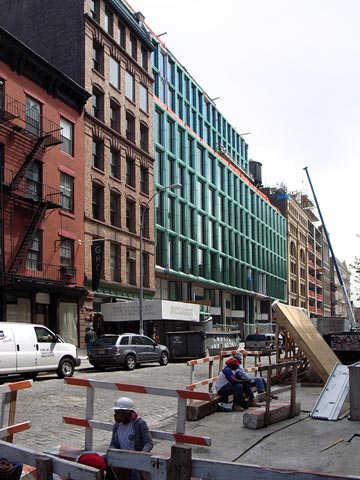
Bond Street
In my comings and goings to and from my apartment/office on the east side, I often walk through Noho, the relatively small area of loft buildings hemmed in by the East Village, Greenwich Village, and Little Italy (Nolita). For years, the neighborhood was dotted with small, odd, seemingly temporary structures, auto shops, gas stations, diners, etc. And lots of parking lots. Some of this lack of cohesion can be explained by the building of the IRT subway way back in the early 1900s when Lafayette Street was ripped through the neighborhood to allow for the cut and cover construction of the tunnel. The demolition left narrow bits of property on each side of the street, which ended up being used, or barely used, for an entire century by the above hodgepodge of structures.
There's lots more history and information to be had here.
In any case, the parking lots and slender strips of property are being developed in the current boomtown climate of New York. The most interesting arechitecturally is Bond Street between Lafayette and the Bowery. Several infill apartments buildings are going up simultaneously, the most notable of which is 40 Bond. Ian Schrager, the Studio 54 entrepreneur ( and tax evader) turned to real esate development after a stint in prison. His residential developments are boutique buildings with an emphasis on design and chic life style. 40 Bond is notable for being the first building designed by the Swiss architects Herzog & de Meuron, who are known for the Tate Modern in London and the de Young Museum in San Francisco.
40 Bond's facade features molded green glass framing around the large windows, and along the street--yet to be assembled--will be a grafitti inspired frieze of cast aluminum. Whatever one thinks of the sleek Schrader packaging of the project, the building embodies the new emphasis on architecture (in the service of real estate) in New York. The other notable aspect of the project is the level of craftsmanship evident, and the richness of materials--in this case the glass framing--something fatally missing in much contemporary architecture.


